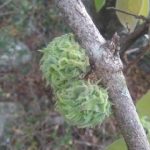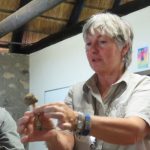TREE LIFE
January 2022
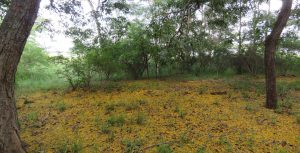
Yellow Carpet of Pterocarpus rotundifolia flowers. Photo: Rob Jarvis
Hi Everyone,
The good news in this issue is that your Society will be going for a meeting at Heather Pocock’s home out at Goromonzi this coming Sunday 16th January 2022. Cars can leave from Tony Alegria’s house in Greendale at 8.30am or alternatively go straight there. Go out on Mutare road, through Ruwa and then turn left onto Goromonzi Road. Travel for 6kms, past the James farm road then you will see a dirt road on the right with a big sign Pakanaka Lodges. Travel down that road for 1.6kms and the Pococck’s gate will be on right marked with a hanging sack. Bring a picnic lunch with your own chairs, drinks and food. We will return home after the lunch but well before dark and the road out from the old Jaggers (now Pick and Pay) to Goromonzi turn-off is a double lane highway so relatively safe.
To cheer you up after this recent spell of rain is a bright yellow carpet of flowers pictured out at Kent Estates at Norton over Christmas. They make an absolute picture at this time of year! The responsible tree is of course the round-leafed bloodwood, Pterocarpus rotundifolia. The top photograph is from near Robin’s Camp in Hwange. Robin’s was offering a very good deal over the Festive Season and we couldn’t resist going. What a wonderful place to relax and enjoy the tree, bird and mammal life.
Enjoy! Mafungi
TREE OF THE MONTH Baikiaea plurijuga
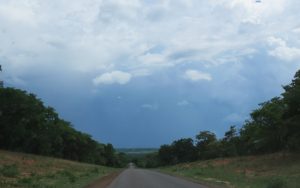
Baikiaea plurijuga forests. Photo: Rob Jarviss
Road travellers in Zimbabwe undoubtedly look in awe at the vast areas along the road from Bulawayo to Victoria Falls that are home to a carpet of teak trees, Baikiaea plurijuga as it is known scientifically. It is a wonderful asset to those few countries where it occurs naturally and it is restricted largely to the Kalahari sands to be found in northwestern Zimbabwe, northern Botswana and Namibia and southern Angola. The Kalahari sands are deep, almost pure sand with no clay and little silt and only where some organic matter accumulates can the forests become established and thrive. The trees are universally deep-rooted and take a long time to get established and achieve any sort of reasonable size. Much of the industrial, commercial and suburban land in Victoria Falls town is graced by exceptional specimens of these trees. Unfortunately the attraction of green lawns, especially in the hospitality industry and for home gardens will probably doom many of the trees to an early extinction. But how much more valuable will all these properties be if in 20, 50 or 100 years from now, if they have these trees growing in a more or less natural environment and benefitting only from the extra water that comes off the roof and roadway?
Unfortunately the world travel industry has been much disrupted by the menace of Covid and Zimbabwe has had a habit of discouraging tourism but one day, one day, vast streams of South Africans will make the long motor trek up into their northern neighbour to visit the Victoria Falls, Hwange National Park and the many other attractions around Zimbabwe. Those of you who have made the long, arduous journeys down to Durban and Cape Town cannot fail but be impressed by the contrast between the hundreds of kilometres of grassland landscape to be found in abundance in our southern neighbour and the well-wooded roadsides on the way up from Bulawayo to the Falls. Baikiaea plurijuga is a legume and a member of the CAESALPINOIDEAE sub-family in which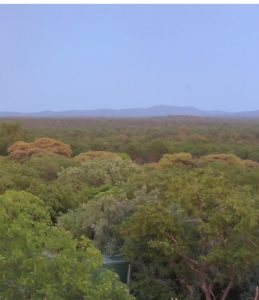
Tower at Robins Camp looking towards Sinamatella Hills, composed of many different kinds of trees including leadwood, mopane, white syringa and jackal berries. We find cassias, musasas and bauhinias amongst many others. The great advantage of the trees is their wood, highly prized for all sorts of uses from parquet flooring to railway sleepers and even xylophone keys. Just after Independence in 1980 we bought 50 teak railway sleepers from the NRZ railyard in southern Harare at the princely sum of 18 cents each and in 2021 some 40 years later we used the last few to make doors, pelmets, a sliding hatch and outdoor railing on a new house we built. The concrete, glass, steel and aluminium that the rest of the house is made from will probably be long gone when the teak finally gives up its tough, hard-wearing characteristics. If only we had the sense to buy 500 sleepers at the time, because they go for US$50 or more each today. Photo by Rob Jarvis on the right – we see a companion forest viewed from the Tower at Robins Camp looking towards Sinamatella Hills, composed of many different kinds of trees including leadwood, mopane, white syringa and jackal berries. Unfortunately you can only wander around there on foot at your peril, lions abound!
Book Reviews by Rob Jarvis
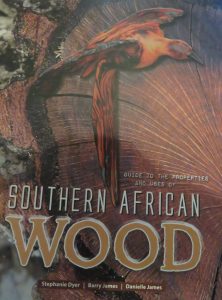 Two books that I am trying to use, both when writing a Tree of the Month article and even when writing generally about any tree that catches my eye when on travels are the two featured here.
Two books that I am trying to use, both when writing a Tree of the Month article and even when writing generally about any tree that catches my eye when on travels are the two featured here.
The first, on the left is the Guide to the properties and uses of Southern African Wood co-authored by Stephanie Dyer, Barry and Danielle James. It has really been done beautifully with each kind of tree having two pages dedicated to it, covering both highly technical data on wood properties, including shrinkage, density, hardness and many other measures. But the best part is the section dedicated to personal testimonies by woodworkers, wood artists, cabinetmakers, joiners and the like detailing practical uses and problems they have found when handling that particular kind of wood. Each species has photographs depicting the wood colour and structure (including the end-grain) and some finished articles made from each. Undoubtedly over the centuries that southern African wood has been used, many heartaches could have been avoided if all the carpenters that came before had access to such detail before embarking on any wood-related project.
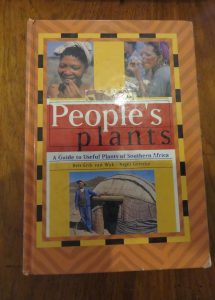 Secondly a book entitled People’s Plants A Guide to useful Plants of Southern Africa by Ben-Erik van Wyk and Nigel Gericke is also a treasure-chest of information. It of course covers much more than trees and the content is neatly divided into three Parts covering Food and Drink, Health and Beauty and Skills and Crafts. It is of great interest I am sure to everyone, to know why local communities might preserve a particular species of tree, even cultivate it in some cases, why some are revered and protected from any form of destruction and why others are pursued, unfortunately sometimes to the very brink of extinction, because the leaves, roots, bark, wood or seed and fruit may have some magical use for human or animal ailments. As time goes on science and practical application will separate the folklore from the reality but in the meantime the huge pressure of burgeoning human populations are having a devastating detrimental effect upon the tree resources of Zimbabwe and beyond. So the more we know and make known to local peoples and the more that localised colonies of rare plants can be protected and/or their gene pools conserved and multiplied, the brighter will be the future for all of us. You only have to travel the major highway from Harare to Norton in the Whitecliff area to see just how destructively the natural woodlands thereabouts have been raided and only the stark green skeletal form of the Euphorbia ingens stand as stark reminders that people can literally raze to the ground every plant remotely useful to them and leave others that have little use, beyond equally destructive, fish-poisoning.
Secondly a book entitled People’s Plants A Guide to useful Plants of Southern Africa by Ben-Erik van Wyk and Nigel Gericke is also a treasure-chest of information. It of course covers much more than trees and the content is neatly divided into three Parts covering Food and Drink, Health and Beauty and Skills and Crafts. It is of great interest I am sure to everyone, to know why local communities might preserve a particular species of tree, even cultivate it in some cases, why some are revered and protected from any form of destruction and why others are pursued, unfortunately sometimes to the very brink of extinction, because the leaves, roots, bark, wood or seed and fruit may have some magical use for human or animal ailments. As time goes on science and practical application will separate the folklore from the reality but in the meantime the huge pressure of burgeoning human populations are having a devastating detrimental effect upon the tree resources of Zimbabwe and beyond. So the more we know and make known to local peoples and the more that localised colonies of rare plants can be protected and/or their gene pools conserved and multiplied, the brighter will be the future for all of us. You only have to travel the major highway from Harare to Norton in the Whitecliff area to see just how destructively the natural woodlands thereabouts have been raided and only the stark green skeletal form of the Euphorbia ingens stand as stark reminders that people can literally raze to the ground every plant remotely useful to them and leave others that have little use, beyond equally destructive, fish-poisoning.
Both books are published by BRIZA of Pretoria, RSA.
OF THORNS AND DAINTY FLOWERS by Rob Jarvis
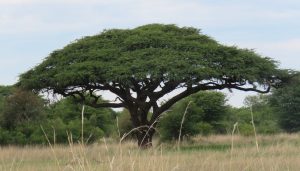
Of course no visit to the great National Parks of Zimbabwe would be complete without sightings of several of the acacias that proliferate in these hot, low environments. Humid in summer, but very hot and dry in the tail end of the winter season it is ideal acacia country. Although this particular tree was photographed just before the intense heavy rain of early January, you can see from the photograph, where clearly not much rain had fallen at that time, still the tree itself was fully clothed with new leaf and immediately under the tree there is a glimpse of lush green, fresh grass growth. This particular tree was almost certainly Vachellia tortilis, given the shape and habitat, but here in Harare on the Agricultural Research Trust Farm we were so impressed by the greening effect of our Vachellia sieberiana and the resistance to frost of the grass growing under the trees that we are opting to re-forest some areas in our paddocks and pastures to give us greater areas of year-round greenery, supplemented by the pods and leaves that fall to the ground or are accessible to cattle that are prepared to arch their heads skywards. Elephant of course, as we know from Mana Pools National Park, are prepared to stand on their hind legs and pluck juicy leaves and pods from canopies way beyond the reach of other ungulates and antelope.
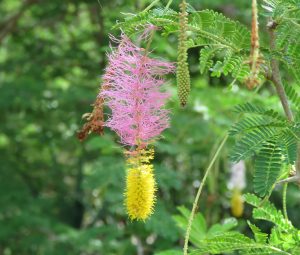
Dichrostachys cinerea . Photo: Rob Jarvis
Although not an acacia, the very prettily-flowered Dichrostachys cinerea or sickle bush grows prolifically in areas that may have been severely over-grazed in times gone past. It then becomes a bit of a nightmare to get under control in a traditional farming or even in a game management situation.
The flowers are striking, with their attractive pink sterile flowers perched above the yellow fertile ones. The pods once formed will be a tangled cluster. Wildlife and livestock love to eat the pods but the trees can form such dense stands that they form almost impenetrable thickets and of course nothing grows underneath these thickets. The wood is very tough and hard, making ideal handles for badzas and the like, but the relatively thin stems means that uses other than as firewood, are quite limited.
BOTANIC GARDEN WALK Saturday 4 December 2021
Jan Van Bel
Another tree outing to look at trees in flower.
Waiting in the car park for more people to arrive we saw Acacia karroo, sweet thorn, with a profusion of yellow flowers that would have been an inspiration to any painter trying to perfect his art of pointillism. Close by Acacia polyacantha, white thorn, was also in bloom with cream white spikes.
We were only four but it was time to start our walk. We took the main path and Tony commented on the beautiful yellow flowers of the Bougainvillea’s . Temporarily confused we looked at the flowers that’s mostly hidden between modified leaves or bracts which give the plant its attractive colors. Between those colored bracts we looked at the nice little pale yellow flowers. Rarely having stopped at this spot, we observed that the two species here are different. One grows tall while the other more shrubby. Their leaves slightly different in size and shape. Mark informed us that there are three different species of Bougainvillea.
Mimusops zeyheri, common red-milkwood, was also in flower. You have to go close by to see its tiny white flowers. At this point a new aspiring member joined our group, introducing himself as Lovemore. Passing by the impressive Ficus hippopotami, swamp fig, we were trying to remember its other scientific name which is Ficus trichopoda. We looked at Khaya grandifoliola, large leaved khaya, whose leaves don’t look bigger than those of K. anthotheca, our local species. Extracts of this tree are used against malaria. Vernicia fordii , Tung tree had already developed its fruits , so we missed the beautiful white flowers, so attractive and planted by many as an ornamental. Tony commented on the use of its oil being of a special interest in the paint industry. One of Mutare’s main streets is beautified with a long line of these poisonous shrubs. A few meters further Terminalia catappa, Indian almond, had quite different leaves than the few specimens we’ve seen so far. This tree has the expected pagoda shape, but its leaves are much less ovoid. The fruit inside the pods taste like almonds.
Before you come to the big Ceiba pentandra, kapok tree, which has palmate leaves, you see a new young tree with leaves quite similar. It had one fully developed fruit which proved to be a Pachira aquatica, Guiana chestnut, from the tropical wetlands in America. We wanted to see if the Galpinia transvaalica was in flower. Its common name implying some beautiful flowers. But no luck and none of us had ever seen this particular tree in flower. What came out to us flaunting a profusion of dainty flowers in panicles was the shrubby Acacia schweinfurthii, river climbing acacia. The next tree we rarely look at, although it has a name tag on it. So for me it is like a new species. Xylia torreana, hairy xylia with compound leaves with only two pinnae with big leaflets, its flowers with long stamens like Albizia and pods like Afzelia, whose leaflets have the same size.
Close to the imposing Ficus rokko was Calodendrum capense, Cape chestnut, in flower. I have seen some other Cape chestnut this year that are exuberantly flowering, more than previous years. Oxyanthus speciosus, wild loquat or whipstick tree.
Farm made compost at Trelawney, Zimbabwe.
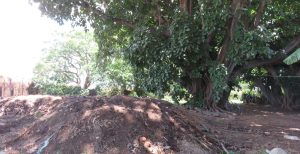
I must admit that over the years that we lived at Rockyvale near St Johns in Rolf Valley I became an ardent believer that you do not need to make artificial compost heaps for the garden needs. However since we moved to ART Farm we were faced with a situation where we have ample space in the garden and a proliferation of very aggressive weeds that we needed to bring under control in particular the orange-flowering Tithonia that occurs in vast swathes around the countryside. Almost by chance we found that this weed is absolutely perfect for compost making and we had such vast amounts that we didn’t really have time to make the heaps in the recommended fashion staggering green matter with manure and/or already rotted compost as starter layers. So we would just pull the plants out of the ground, complete with adhering soil and leaf litter and shake this off onto the layer below before putting the lush green stalks of the Tithonia onto the heap. When the heap was about 1 metre high we would then cover it with mature compost from an earlier heap and just leave it. Amazingly within about 3 to 5 weeks it had all broken down into usable compost. This then goes onto the freshly planted fruit and garden trees and the vegetables growing in partnership. We have since started eating fresh, organic fruit from figs, pomegranates, tree tomatoes, mulberries, untouched by synthetic fertilisers and chemicals. And all within one year of planting out and the mangoes, papayas, grapes and litchis are on their way too!!! Cheers Here’s to your good health! Mafungi
CHAIRMAN TONY ALEGRIA


